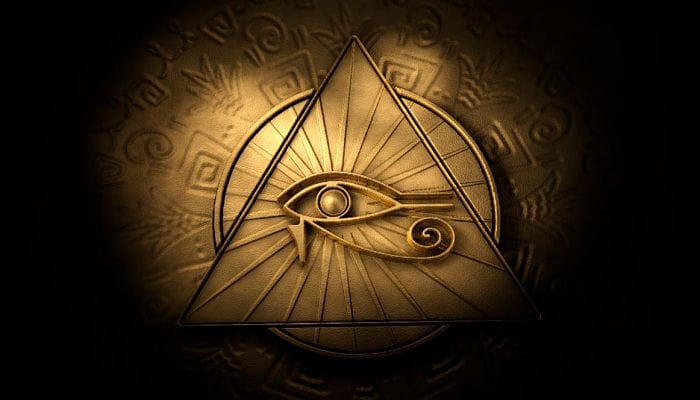The Eye of Horus, also known as the Wadjet or Ujat, is an ancient Egyptian symbol of protection. The symbol incorporates an eye along with an eyebrow and is decorated with the markings of a falcon’s eye. It is also known as the Eye of Ra, but the Eye of Ra, however, was seen as a destructive force connected to the powerful heat of the sun. In contrast, the Eye of Horus was often depicted on amulets to offer protection to the living and the dead, and it also represented good health and power.

Myth of Horus
Horus was a sky god in ancient Egyptian mythology, traditionally represented by a falcon. His eyes were said to be associated with the sun and moon alternately. A myth related to Horus tells the story of Set, Horus’ uncle. Set allegedly murders Horus’ father, Osiris. After his father’s death, Horus and his mother, Isis, want to revive Osiris and vow to reassemble his dismembered body parts. In one version of the myth, Horus offers one of his own eyes to resurrect his father. Another interpretation says that he lost his eye in a battle with Set.
The myth holds that Horus’ left eye was removed. The left eye was believed to be connected to the moon, as it could be seen being torn from the sky with the effect that the moon waxed and waned. Thoth, an Egyptian deity, supposedly restores Horus’ eye, resulting in his eye becoming known as Wadjet, meaning whole or healthy. The restoration of the eye also represented the change from chaos to order, paralleling the Egyptian concept of perfect order or Maat.
Eye of Ra
The Eye of Ra is seen as another name for the Eye of Horus by some sources, but it is also considered by others to be separate and related only to Ra. The Eye of Ra supposedly has more destructive connotations. Sources reveal that Ra, the ruler of Egypt at the time, was beginning to age and weaken. As a result, his people did not take him seriously and anarchy took over. Ra decided to punish the people. He took his daughter out of the Ureas, the royal serpent, and sent her to punish humanity.
She orchestrated a massacre and eventually had to be recalled by Ra, who feared she would destroy all of humanity. Unfortunately, she was bent on destruction and did not yield to her father’s wishes. To prevent her from causing more bloodshed, Ra tricked her into gorging herself on the blood of her victims. He prepared a mixture of beer and pomegranate juice to dye the liquid the color of blood. She became intoxicated by the alcoholic mixture and passed out, thus saving the rest of the population.
Another notable difference between the two symbols is the color of the iris. The Eye of Ra is usually depicted with a red iris, compared to the blue iris of the Eye of Horus.
In mathematics
The Eye of Horus was also used as a system of measurement and was divided into six sections, denoting the six pieces of Horus’ shattered eye. Each of the six pieces represented a fraction as well as one of the senses. The ancient Egyptians used this method to create more complex fractions. Strangely, when all the fractions are added together, they do not add up to 1, but 63/64. The extra 1/64, sources say, may have been a sign of the magic of Thoth who restored the eye of Horus. The Egyptians also believed that it was not possible to achieve perfection in anything, and the missing part of the fraction may have alluded to this concept.
Modern Use

The symbol is believed to be connected to the Eye of Providence on dollar bills and possibly linked to Freemasonry. The Eye of Providence, Eye of Horus, and similar symbols representing an eye are considered by conspiracy theorists to be symbols of the Illuminati.
The Thelemites, a group of occultists, refer to the early 20th century as the Age of Horus. In Theosophy and other esoteric studies, the Eye of Horus is connected to the pineal gland, which is believed to be the third eye. Modern scientific research considers the pineal gland to be an old photoreceptor.
In certain species, it is linked to a parietal eye also called the third eye. Philosophers such as René Descartes believed that the pineal gland was the seat of the soul. The ancient Egyptians believed that the Eye of Horus provided protection. Does it still protect the living and the dead today, or does it rather tirelessly watch over every movement of the proletariat?

